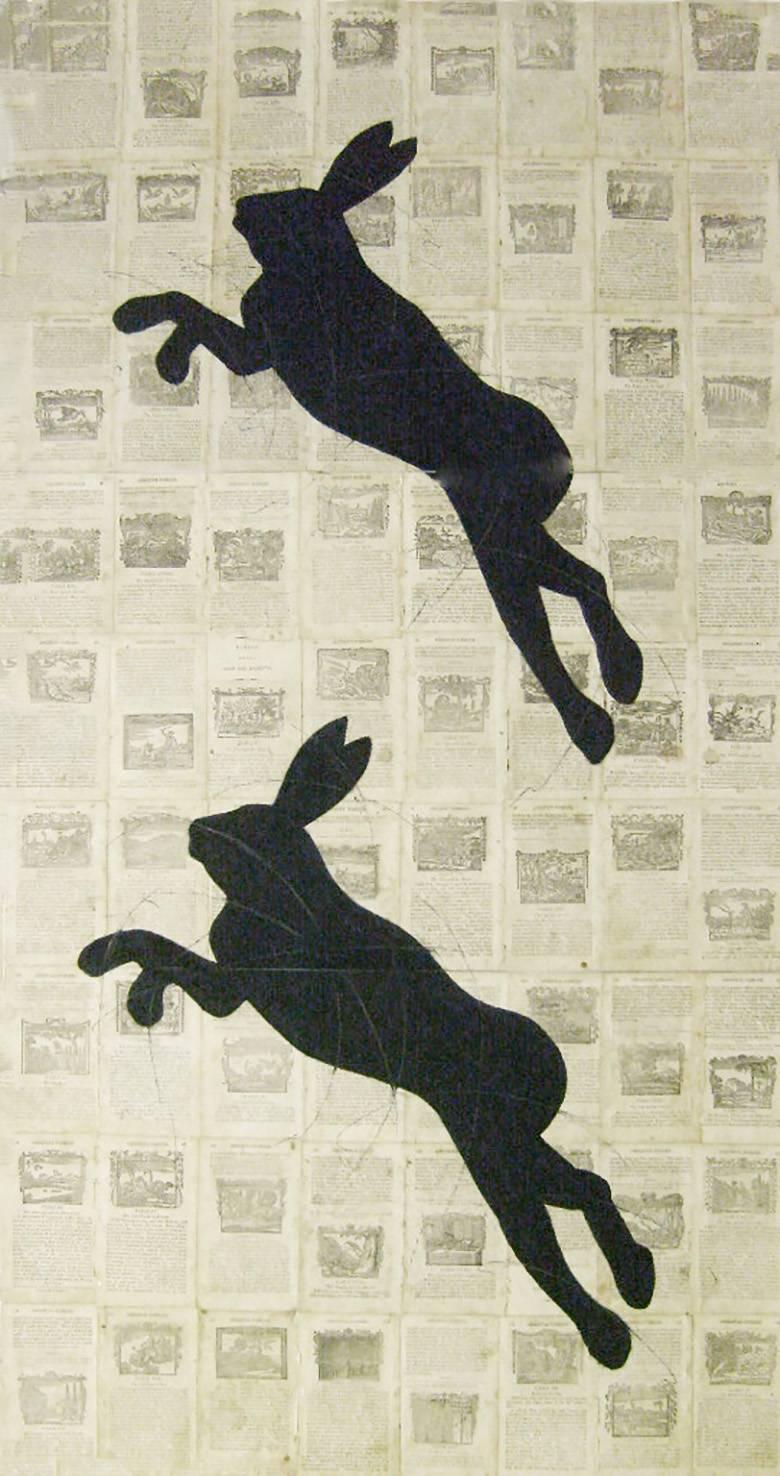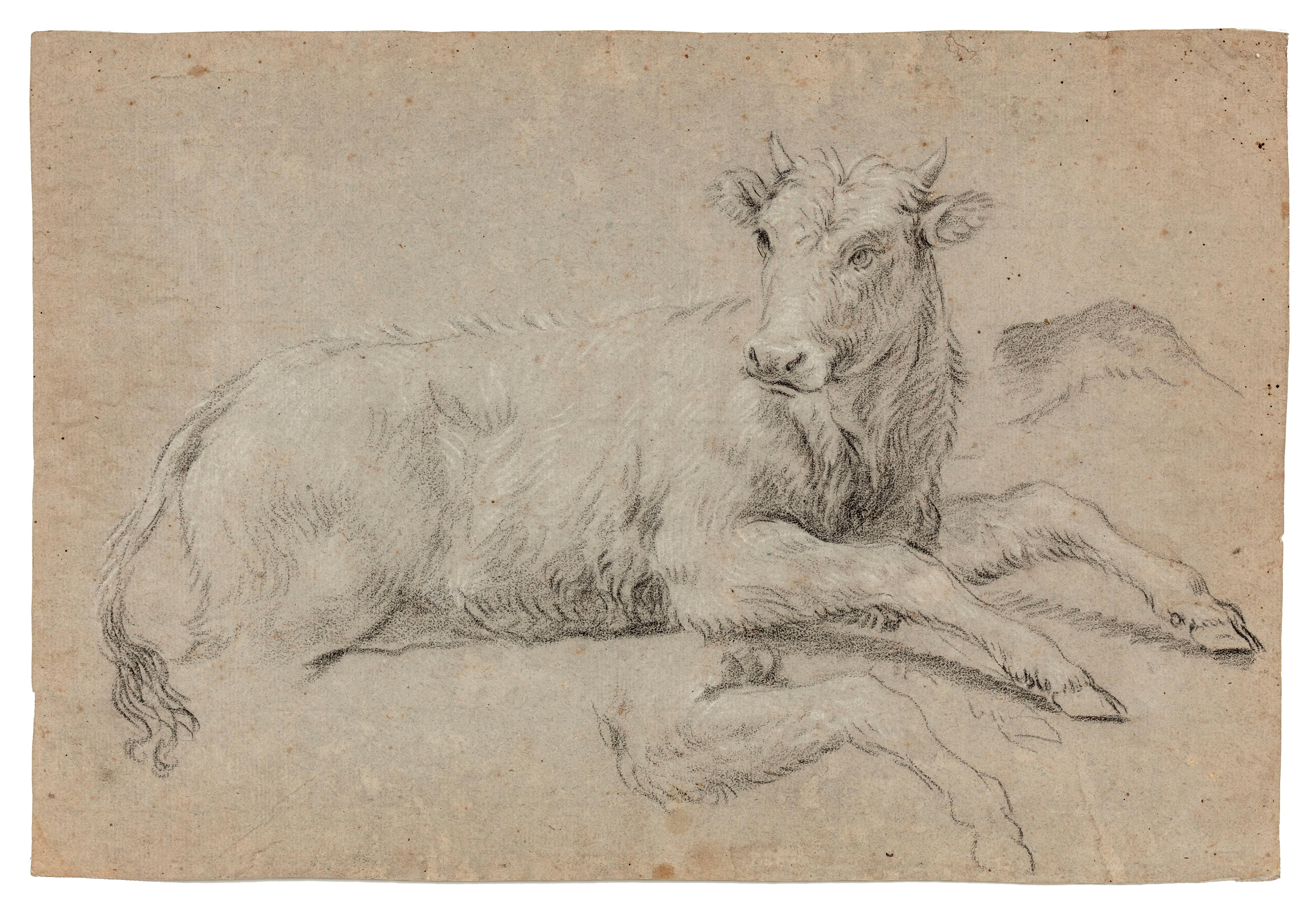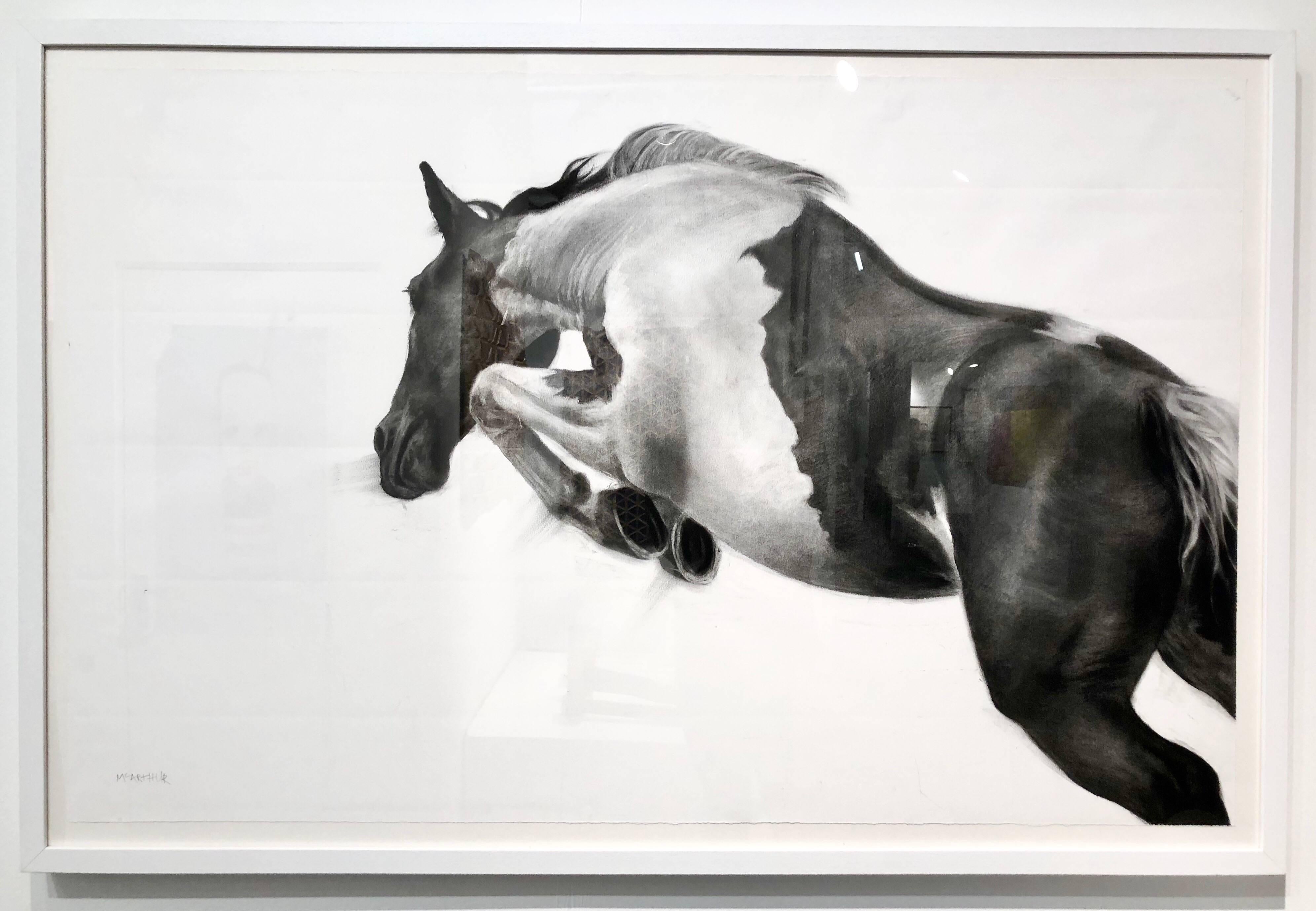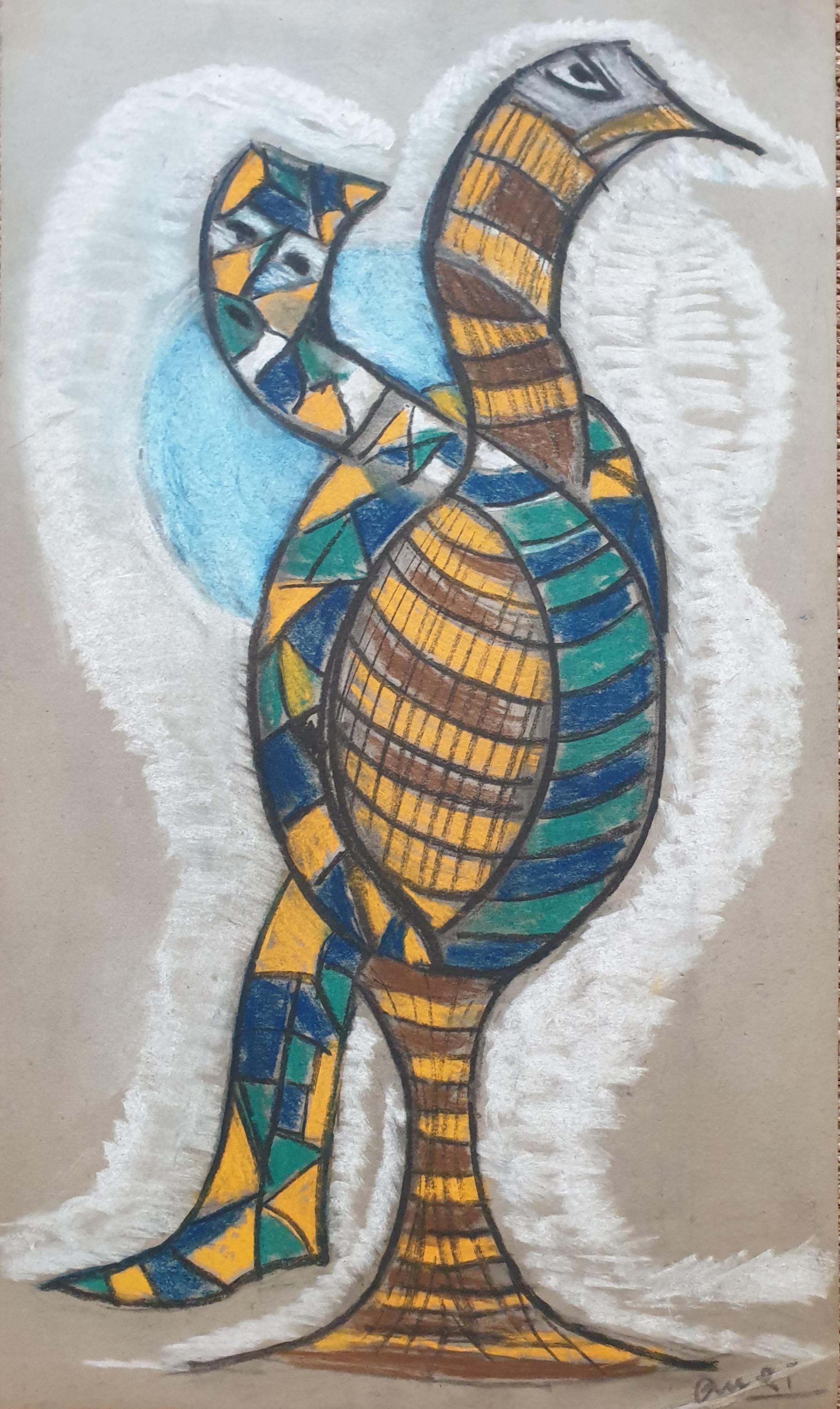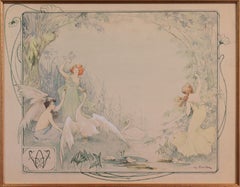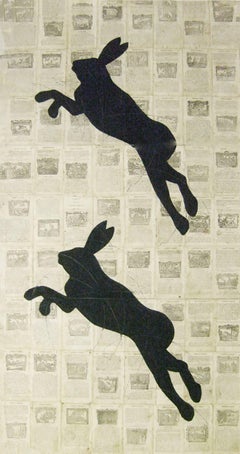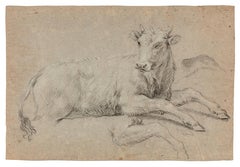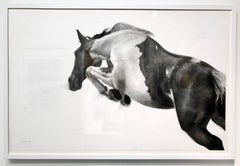Items Similar to Trotting Horses Harnessed To A Lightweight Four Wheel Cart Trap Framed Original
Want more images or videos?
Request additional images or videos from the seller
1 of 24
Cecil Charles Windsor Aldin, R.B.A.Trotting Horses Harnessed To A Lightweight Four Wheel Cart Trap Framed Original
About the Item
Cecil Charles Windsor Aldin.
English ( b.1870 - d.1935 ).
Trotting Horses Harnessed To A Lightweight Four Wheel Cart Trap.
Chalk On Paper.
Signed Lower Right.
Image size 19.3 inches x 27.8 inches ( 49cm x 70.5cm ).
Frame size 30.1 inches x 38.4 inches ( 76.5cm x 97.5cm).
Available for sale; this original drawing in chalks is by Cecil Aldin and dates from the early part of the 20th century.
The artwork is presented and supplied in a walnut veneered pine frame from the mid-late 1970s (which is shown in these photographs). The mount and backing board have been replaced with conservation materials more recently. The glass has been replaced at the same time with non-reflective glass (Tru Vue UltraVue® UV70 glass). The previous gallery and framing labels have been retained and mounted on the rear of the backboard.
This antique drawing is in excellent condition, commensurate with its age. It wants for nothing and is supplied ready to hang and display.
The drawing is signed lower right.
Formerly with the Hampton Hill Gallery, Middlesex, London.
From the late 1880s to the 1930s the British artist and illustrator Cecil Aldin was a household name with a substantial public following. Today, he is regarded as being one of the most original and very best sporting artists of the twentieth century and his work is highly collectable. As an artist Aldin preferred to work in pencil or water color, but also produced pastels and many fine etchings. His works show great humour and precision and he was a master of caricature in the drawing of both humans and animals. Aldin was also a man of great charm and led a full, industrious and interesting life.
Cecil Charles Windsor Aldin was born in Slough, Buckinghamshire on 28 April 1870 to Charles and Sarah Aldin, (nee Windsor). He had two brothers and a sister. His father Charles was a building contractor and himself an amateur artist. Cecil was a wiry red-haired boy who started sketching at the age of 6, and showed an obvious talent, which his father encouraged. His early drawings are of animals and the countryside, with a recurrent theme of a rider being thrown from a horse, expressing his developing sense of humour.
Cecil became a boarder at Eastbourne College, but later, due to a dip in the family financial circumstances, attended Solihull Grammar School. He did not excel at school but wanted to study art. He initially studied under Albert Moore at the National Art Training School (which later became the Royal College of Art). He then studied anatomy at South Kensington and animal painting at Midhurst, Sussex, under Frank Calderon, who went on to found the School of Animal Painting in 1894. Aldin had to leave here when he developed rheumatic fever, a condition which troubled him intermittently for the rest of his life. Whilst the years of study may have refined his techniques, his talent was innate and he had a great affinity with animals, especially dogs and horses.
Aldin then moved back to live with his family, now in Clapham, until he began to sell his artwork regularly. His first sale was a drawing of a dog show which he sold to Graphic around the time of his twenty first birthday. From this small beginning he rapidly established himself as a productive and versatile artist. He moved to Chelsea, where he rented a studio, and would often draw in the London Zoological Gardens to widen his repertoire. He then moved to Bedford Park, Chiswick where he became friends with a number of other artists, including Phil May, John Hassell and Lance Thackeray. This exposed him to a variety of ideas and techniques. He became part of the brotherhood of Bohemian artists who worked and played hard and between them formed the London Sketch Club.
An early commission came from a Master of Foxhounds who wanted a portrait of an old polo pony. Aldin’s payment for this was the horse itself, which he housed in a bicycle shed. He used this horse to hack with meets at Esher. He soon obtained a second horse, also bartered in exchange for a portrait and before long had accumulated a menagerie of two horse, a Shetland pony, a donkey, two monkeys and thirteen dogs!
Aldin went on to hunt with his own pack of harrier beagles and for five seasons during World War I he was Master of the South Berkshire Foxhounds. He hunted in at least 30 counties and was able to persuade a leading sporting paper to employ him as a hunting correspondent. Thus, he combined his sporting interests with his art, one supporting the other.
Aldin became hugely successful as an illustrator and was asked to illustrate Rudyard Kipling’s Jungle Stories in Pall Mall Budget (1894-95), R.S. Surtees’ famous hunting character Jorrocks, Dicken’s Pickwick Papers, an edition of Black Beauty and many other books. He also contributed to Ladies Pictorial, Illustrated London News, Sketch, The Gentlewoman, Illustrated Sporting and Dramatic News, The Queen, Punch, Boy’s Own Paper and many others. He also produced many posters, particularly for Cadburys, and designed a range of china for Royal Doulton.
Aldin was recognised by his fellow artists as well as the public. He became a member of the Royal Society of British Artists, the London Sketch Club and the Chelsea Arts Club.
He had many paintings exhibited; a first exhibition in Paris in 1908 led to a second the following year, which was received with much acclaim and extended his fame to a wider audience. He became a close friend of Lance Thackery and together they explored Kent in a donkey cart!
In 1895 Cecil married Marguerite Morris, and they lived first in Bedford Park, where their son Dudley was born, then at Chiswick, where their daughter Gwendoline was born. They subsequently moved to Henley-on-Thames. The birth of his children inspired a series of nursey pictures which became very popular. The family subsequently moved to Henley-on-Thames as Aldin’s interest in hunting, horses and dogs increased. In 1910 he became Master of the South Berkshire Hunt as well as being associated with other local packs. He lived at Sulhamstead Abbots from 1913-14 and was Church warden of St Mary’s church.
When the First World War broke out Aldin was too old for active duty, but he made a significant contribution to the war effort. He became a Remount Purchasing Officer in charge of an Army Remount Depot. One of the men who worked under him was Alfred Munnings. The military demand for horses was high and it must have been difficult for him that Aldin’s own mounts were among the first to be given up to the army. Aldin set up a number of Remount Depots around Berkshire including, as an experiment, one run entirely by women. This was deemed a success and following this as number of Ladies’ Army Remount Depots were established, with his wife and daughter both making their own contributions to this work. There is no doubt that Aldin’s enlightened championing of women’s abilities boosted the war effort, as was acknowledged in the press at the time.
Aldin thus came to the attention of the Women’s Work Sub-Committee of the newly formed Imperial War Museum and in 1919 they asked to purchase two of his wartime paintings. One was released straight away – ‘Women Employed in the Remount Depot’. Aldin was however reluctant to release the second one, entitled ‘A Land Girl Ploughing’, because it had been done on old reused canvas using leftover scene paint and he considered it not suitable for a national collection. He therefore replicated the painting with better quality materials, using a member of the Women’s Land Army to model, so that all details of the uniform were correct. The painting is considered among the most iconic images of the work of the Women’s Land Army from World War One. Aldin also formed a pack of beagles for the Royal Flying Corps, which was the start of the hounds at RAF Cranwell. Aldin’s son, Dudley, served in the Great War as a second-lieutenant with the Royal Engineers. He was killed in action at Vimy Ridge in May 1916. He was just 19. This had a profound effect on Aldin and the style of his work thereafter.
After the war Aldin, who was known for his warmth of character, spent much of his time organising pony and dog shows in both the south of England and France. In 1919 he co-wrote a play for children entitled The Happy Family in which three children learn the language of the animals around them. This was produced at the Prince of Wales Theatre and later at The Strand. He also continued to paint, often large equestrian portraits. In the 1920s he completed a superb set of nostalgic prints of old coaching inns, cathedrals and manor houses, many of which continue to be reproduced on Christmas and greetings cards.
In addition to his work as an illustrator Aldin also wrote numerous books himself, which he illustrated, including Rat Catcher to Scarlet (1926), Dogs of Character (1927), Romance of the Road (1928), An Artist’s Models (1930), Mrs Tickler’s Caravan(1931) and his autobiography, Time I was Dead (1934). It has been said that his brightly colored books with the illustrations simply outlined were the staple diet of country houses between the wars. His great ability was always in capturing the essence of a scene or the spirit of an animal.
Aldin suffered for most of his life from rheumatoid arthritis, which was aggravated by a hunting fall, and caused him to finally give up hunting. When this started to seriously affect his hands, he and his wife retired to the Beleric Islands in 1930, hoping that the warmer climate would ease his condition. They took their beloved dogs with them and made a home at Camp de Mar, Majorca, where he continued to work, and indeed produced some of his best paintings.
In 1935 Aldin travelled back to England for an operation but suffered a heart attack whilst still at sea. When his ship docked, he was rushed to the London Clinic but could not be saved. He died in London on 6 January 1935. Back in Majorca his wife had been perplexed by the most extraordinary and unprecedented howling of his Aldin’s one remaining dog, Cracker. Several hours later she received the news that her husband had died. She could not ascribe the dog’s behaviour to anything other than a psychic link between the man and his dog. Aldin’s death made front page news on both sides of the Atlantic and his obituary notice in The Times said that “Cecil Aldin can be described as one of the leading spirits in the renaissance of British sporting art”. A memorial exhibition was held in 1935. The British Sporting Art Trust held a loan exhibition of his work at the Leicestershire Museum and Art Gallery; the Alpine Gallery, London; Sotheby’s, West Sussex, and in Paris in 1990/91.
Today, his works are held by the National War Museum, and notable collections world-wide.
© Big Sky Fine Art
This is an original chalk drawing dating from around the beginning of the twentieth century.
It depicts two brown horses, one darker than the other, each with white fetlocks and white blaze. They are harnessed to a lightweight trap or simple cart and are trotting. The driver, a middle-aged gentleman, is seated in the trap, and wearing a brown coat, trousers and a grey bowler hat. He has a white moustache and an expression of concentration and contentment. He is leaning forward and holding the reigns in his hands. The overall impression is one of grace and ease, created with a masterly touch and the minimum of fuss. A really classy piece.
- Creator:
- Dimensions:Height: 30.12 in (76.5 cm)Width: 38.39 in (97.5 cm)Depth: 0.99 in (2.5 cm)
- Medium:
- Movement & Style:
- Period:
- Condition:This antique drawing is in excellent condition, commensurate with its age. It wants for nothing and is supplied ready to hang and display.
- Gallery Location:Sutton Poyntz, GB
- Reference Number:1stDibs: LU489314150012
About the Seller
5.0
Vetted Professional Seller
Every seller passes strict standards for authenticity and reliability
Established in 2010
1stDibs seller since 2016
120 sales on 1stDibs
Typical response time: 1 hour
- ShippingRetrieving quote...Shipping from: Sutton Poyntz, United Kingdom
- Return Policy
Authenticity Guarantee
In the unlikely event there’s an issue with an item’s authenticity, contact us within 1 year for a full refund. DetailsMoney-Back Guarantee
If your item is not as described, is damaged in transit, or does not arrive, contact us within 7 days for a full refund. Details24-Hour Cancellation
You have a 24-hour grace period in which to reconsider your purchase, with no questions asked.Vetted Professional Sellers
Our world-class sellers must adhere to strict standards for service and quality, maintaining the integrity of our listings.Price-Match Guarantee
If you find that a seller listed the same item for a lower price elsewhere, we’ll match it.Trusted Global Delivery
Our best-in-class carrier network provides specialized shipping options worldwide, including custom delivery.More From This Seller
View AllArt Nouveau Watercolor Painting Naked Lady Red Boa Skating Pulled By A Poodle
Located in Sutton Poyntz, Dorset
Oscar Wilson.
English ( b.1867 - d.1930 ).
The Lady Of The Lake.
Watercolor & Ink On Paper.
Signed Lower Left.
Image size 17 inches x 10.2 inches ( 43cm x 26cm ).
Frame size 23 inc...
Category
Early 20th Century Art Nouveau Figurative Drawings and Watercolors
Materials
Ink, Watercolor, Paper
Hawk Bird Of Prey Framed Original Mid 20th Century Powerful Watercolor Painting
By Elisabeth Frink
Located in Sutton Poyntz, Dorset
Dame Elisabeth Frink.
English ( b.1930 - d.1993 ).
Hawk, 1969.
Watercolor.
Signed & Dated Lower Right.
Image size 25.4 inches x 19.5 inches ( 64.5cm x 49.5cm ).
Frame size 34.4 inches x 28.1 inches ( 87.5cm x 71.5cm ).
Available for sale; this original painting is by Dame Elisabeth Frink and is dated 1969.
The painting is presented and supplied in a glazed frame and mount dating from June 1997.
This vintage watercolor is in very good condition, commensurate with its age.
The watercolor is signed and dated lower right.
Previously with Beaux Arts, London and Bath in 1999.
Dame Elisabeth Frink was one of Britain’s most important post-war sculptors, an accomplished draughtsman, illustrator and teacher. She was part of the post-war school of expressionist British sculptors dubbed the Geometry of Fear, and enjoyed a highly acclaimed career that was commercially successful, broke boundaries and contributed greatly to bringing wonderful sculpture to public places.
She was born on 14 November 1930 in Thurlow, the daughter of a cavalry officer, and brought up in rural Suffolk near to an active airbase. She was brought up a Catholic and educated at the Convent of the Holy Family, Exmouth.
She then studied at the Guildford School of Art from 1947-1949 under Willi Soukop and Henry Moore’s assistant, Bernard Meadows, and then at the Chelsea School in London 1949-1953. She taught at Chelsea School of Art 1951-61, St. Martin’s School of Art 1954-62 and was a visiting instructor at the Royal College of Art 1965-1967, after which she lived in France until 1973.
Frink first came to the attention of the public in 1951 at an exhibition at the Beaux Arts Gallery, London. In 1952 she represented Britain at the Venice Biennale, being described by Herbert Read as “the most vital, the most brilliant and the most promising of the whole Biennale”. The same year the Tate bought its first work by her, and she began to enjoy commercial success. Thereafter she exhibited regularly and was for 27 years associated with Waddington’s, London.
The subjects which Frink was most concerned with were man, dog and horses, with and without riders. Interestingly she seldom sculpted the female form, drawing on archetypes of masculine strength, struggle and aggression. Her work has the recurring themes of the vulnerable and the predatory, in the spirit of an authentic post-war artist. It has been said that she was more concerned with representing mankind that portraits of individuals.
The appeal of her work lies in its directness, provoking a frank statement of feeling. The anatomy is often exaggerated or incorrect; the impact growing more out of her interest in the spirit of the subject. Her animals and birds may be drawn from nature but verge on the abstract, conveying raw emotion and character rather than a realistic depiction. Her unique style is characterised by a rough treatment of the surface which embeds each piece with vitality and her personal impression. In her later work even the distinction between human and bird figures becomes blurred. Commentators have noted that the often rugged, brutal and contorted surfaces of her work reflect the destruction and terror of the six-year world-wide conflict that she witnessed as a child. Frink was an active supporter of Amnesty International.
In the 1960s and early 1970s Frink produced a notable series of falling figures and winged men. Later, living in France during the Algerian war, she began making heads, blinded by goggles which had a threatening facelessness.
Frink produced many notable public commissions, including Wild Boar for Harlow New Town, Blind Beggar and Dog for Bethnal Green, Noble Horse and Rider for Piccadilly, London, a lectern for Coventry Cathedral, Shepherd for Paternoster Square beside St. Paul’s Cathedral and a Walking Madonna for Salisbury Cathedral. In the early 1980s she produced a set of three larger than life figures The Dorset Martyrs which stand on the edge of the old walled town of Dorchester on the site of the old gallows, as a memorial to those who had been executed there ‘for conscience sake’.
Frink’s Canterbury Tales was a collection of 19 etchings drawn directly on to copper plates and etched by her. The ‘book’ was issued in three limited editions. Her illustrations have been praised as “amongst the most successful illustrations of the century, encompassing the mood of the text in concise delineations and disarmingly ribald humour”. She illustrated other books with colored lithographs or drawings.
Frink was on the Board of Trustees, British Museum from 1976, and was a member of the Royal Fine Art Commission 1976-81. CBR (1969), DBE ((1982), Associate of the Royal Academy (1971), Royal Academy (1977). She was made a Companion of Honour in 1992. She died on 18 April 1993, but not before completing her last commission, a monumental but unusual figure of Christ for the front of the Anglican Cathedral in Liverpool, unveiled a week before her death.
For several decades Frink exhibited widely in the UK and abroad. In her later years she lived and worked in Dorset where her home and garden became an arena for her work.
In 1985 she had a retrospective at the Royal Academy. She died on 18 April 1993, but not before completing her last commission, a monumental but unusual figure of Christ for the front of the Anglican Cathedral in Liverpool, unveiled a week before her death. There was a memorial show at Yorkshire Sculpture Park, Bretton Hall in 1994.
Today Frink is venerated as one of the great twentieth century British sculptors. Her unique work is represented in the Tate Gallery and major public and private collections world-wide.
© Big Sky Fine Art
This original watercolor on paper painting of a hawk by Dame Elizabeth Frink...
Category
Mid-20th Century Modern Animal Paintings
Materials
Paper, Watercolor
Welsh Sheepdog And Shepherd Herding Sheep A Mountain Landscape Framed Painting
Located in Sutton Poyntz, Dorset
Malcolm Edwards.
Welsh ( b.1934 ).
Welsh Sheepdog, Shepherd & Sheep.
Watercolor.
Signed Lower Right.
Image size 8.9 inches x 19.7 inches ( 22.5cm x 50cm ).
Frame size 16.7 inches x ...
Category
Late 20th Century Realist Landscape Drawings and Watercolors
Materials
Paper, Watercolor
$2,098 Sale Price
20% Off
Driving Sheep On Plaisters Lane Sutton Poyntz Weymouth Dorset The Jurassic Coast
By Henry Charles Fox
Located in Sutton Poyntz, Dorset
Henry Charles Fox.
English ( b.1855 - d.1929 ).
Driving Sheep. Plaisters Lane, Sutton Poyntz, Weymouth, Dorset 1918.
Watercolor On Paper.
Signed & Dated 1918.
Image size 18.9 inche...
Category
Early 20th Century Victorian Landscape Drawings and Watercolors
Materials
Paper, Watercolor
Horse With Rising Sun Modern British Northern Art Japanese Aesthetic Watercolor
By Geoffrey Key
Located in Sutton Poyntz, Dorset
Geoffrey Key.
English ( b.1941 ).
Horse With Rising Sun, 1989.
Watercolor & Ink On Paper.
Signed & Dated Lower Right.
Image size 13.6 inches x 9.7 inches ( 34.5cm x 24.5cm ).
Frame size 20.5 inches x 16.5 inches ( 52cm x 42cm ).
Available for sale; this original painting is by Geoffrey Key and is dated 26th September 1989.
The watercolor is presented and supplied in a sympathetic and contrasting contemporary frame (which is shown in these photographs) to suit the subject coloration, mounted using conservation materials and behind glass.
This artwork and its presentation is in excellent condition. It wants for nothing and is supplied ready to hang and display.
The watercolor is signed and dated lower right.
Geoffrey Key is a leading figure in Northern contemporary art, widely regarded as Lancashire’s greatest living artist, noted for his realism, his expressive use of bold color and his graphic, linear style. His striking works, now much in demand, have established him as a major player of post war British figurative art.
Geoffrey Key was born in Rusholme, Manchester in 1941. His mother, Marion, worked as an illustrator and encouraged him to draw and he took to this easily and with great enthusiasm. He was educated at Manchester's High School of Art, whose headmaster, Ernest Goodman, established the Salford Art Club. It is fitting that many years later, after Goodman's death, its members chose Geoffrey Key as Honorary President. In 1958 Key enrolled at the Manchester Regional College of Art, where he was tutored by the sculptor Ted Roocroft and the painter Harry Rutherford, both of whom influenced him greatly. After gaining the National Diploma of Design and the Diploma of Associateship of Manchester, the latter with distinction, Key took up a postgraduate scholarship in sculpture.
His academic awards include the Heywood Medal in Fine Art and the Guthrie Bond Travelling Scholarship.
Geoffrey Key’s early work included an important period of development during which he concentrated on painting and drawing a specific area of the Derbyshire landscape, the Whiteley Nab hill, south of Glossop. Key created literally hundreds of images of this one landscape and later revealed that the sole purpose of this dedicated period of study, was to build upon the firm foundation established by his academic training, whilst divesting himself of the influences he had absorbed in order to arrive at his own personal artistic language. In other words, this is where he found his own style.
After graduating Key worked as a teacher at Duke Street Secondary Modern in Broughton, Salford, which later became Broughton Modern. In every spare moment though he painted and his talent was quickly recognised. As the likes of Salford Art Gallery, The Rutherston Loan Collection and North West Arts began to acquire his work he made the decision to relinquish his salary and to become a full time artist.
Key was elected to membership of the Manchester Academy of Fine Arts in 1968 and was a prize winner in 1971. During this time he was also commissioned by three North West England based companies – Mather & Platt, Richard Johnson & Nephew, and Wilson’s Brewery. The Richard Johnson & Nephew pictures are now held by the Museum of Science and Industry, Manchester.
In the 1980s the French company Société des Caves de Roquefort also commissioned Key’s work and further successful exhibitions were held in both the UK and abroad. In 1987 the Manchester Evening News asked Key to write an article on L. S. Lowry, who Key had known well, for a feature marking the centenary of the artist's birth. This article was accompanied by a contemporary drawing of Lowry by Key. Apart from LS Lowry, Key is arguably Lancashire’s best-known and most collected contemporary artist. Key says ‘I knew Lowry and he was a lovely...
Category
Late 20th Century Abstract Impressionist Animal Drawings and Watercolors
Materials
Paper, Ink, Watercolor
Large Framed Welsh Pastel Flock Of Sheep Modern British Artwork From West Wales
Located in Sutton Poyntz, Dorset
Susan Pomery Wilks.
English ( b.1945 - d.2023 ).
Flock Of Sheep.
Pastel & Charcoal On Paper.
Signed Lower Right.
Image size 13.6 inches x 23 inches ( 34.5cm x 58.5cm ).
Frame size 2...
Category
Late 20th Century Abstract Animal Drawings and Watercolors
Materials
Paper, Charcoal, Pastel
You May Also Like
'Three Young Beauties', Art Nouveau, Boston Museum of Fine Arts, Musée Bordeaux
Located in Santa Cruz, CA
Signed lower right, “Ch. Henrida” for Charles Henrida (French, 1854-1924) and painted circa 1900.
Unframed and displayed in a beveled, ivory mat with gilt inner slip.
Matted dimens...
Category
Early 1900s Art Nouveau Figurative Drawings and Watercolors
Materials
Paper, Watercolor, Gouache
Ancient, Original, Modern Fables with Hares (Graphic Collage with Chalk & Paper)
Located in Hudson, NY
chalk on vintage collaged paper from a book of fables
Artwork measures 60 x 32 inches
65. x 35.5 inches framed, deckle edge paper is floated in n...
Category
2010s Contemporary Animal Drawings and Watercolors
Materials
Paper, Chalk
Study of a Bull and Study of Two Heads with Laurel Crowns (recto and verso)
Located in New York, NY
Provenance:
(Possibly) Wilhelm Suida; thence by descent to:
Robert L. and Bertina Suida Manning, New York, until 1996
Private Collection, USA
Traditionally attributed to the French...
Category
17th Century French School Drawings and Watercolor Paintings
Materials
Paper, Chalk
The Great Escape by Patsy McArthur - unique charcoal on paper - white box frame
By Patsy McArthur
Located in Dallas, TX
This is a beautiful and unique charcoal on paper drawing. The Fabriano paper is a high quality watercolour grade set in a custom white wood frame, all archival materials.
Scottish ...
Category
2010s Realist Figurative Drawings and Watercolors
Materials
Conté, Charcoal, Archival Paper
Abstract Expressionist CoBrA Style Anthropomorphic Bird. Chalk on Paper.
Located in Cotignac, FR
Abstract expressionist CoBrA style chalk on paper of an imaginary bird by French artist, A Nuchy. Signed to the bottom right.
Highly colourful and inventi...
Category
1970s Abstract Expressionist Animal Drawings and Watercolors
Materials
Paper, Chalk
Northern Parula
Located in Columbia, MO
Hannah Reeves
Northern Parula
2024
13 x 11 framed
Category
21st Century and Contemporary American Modern Animal Drawings and Waterc...
Materials
Chalk, Photographic Paper, Graphite
Recently Viewed
View AllMore Ways To Browse
Horse Frame
Horse Art Framed
The Trap
1990s Framed Photographs
Old Man A S
Early English B
Used Traps
Horses And Women
Large Framed Antique Drawing
Black And White Etchings Drawings
Large Framed Horse Paintings
Bicycle Frame
Man And Horse Painting
English Renaissance Painting
English Garden Drawing
Framed Equestrian
French Style Frames For Pictures
Road To The Sea

